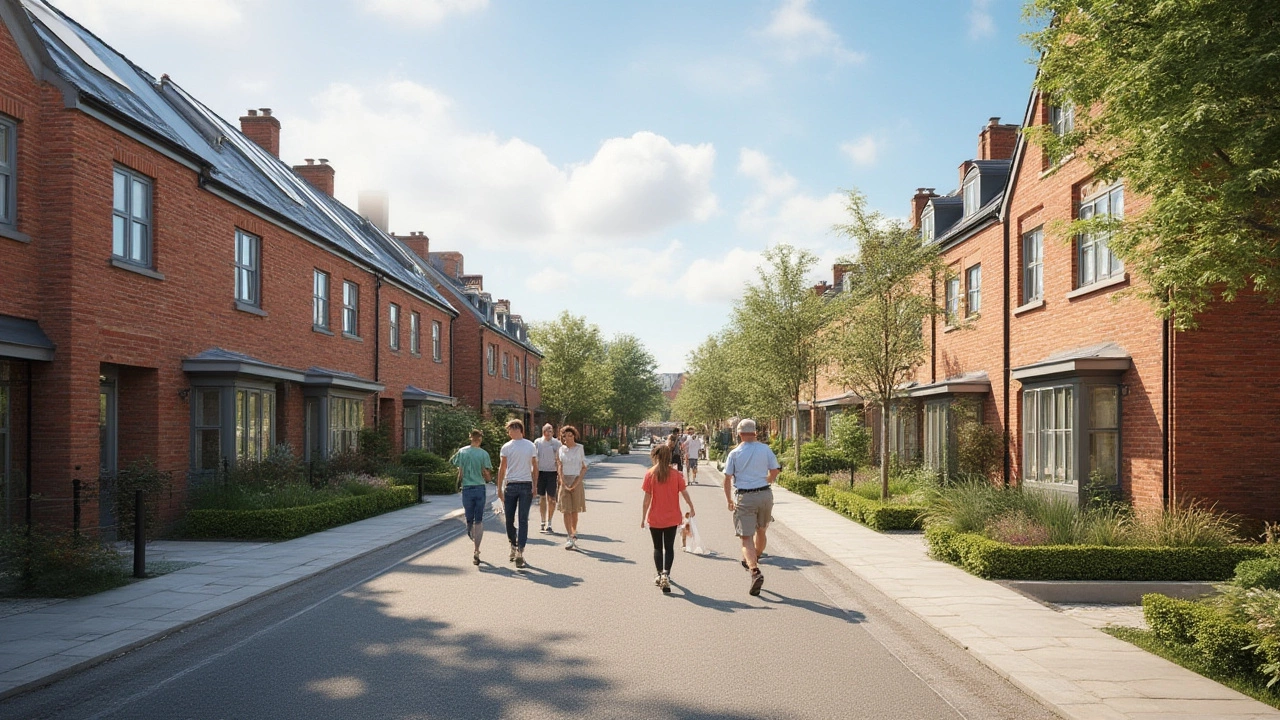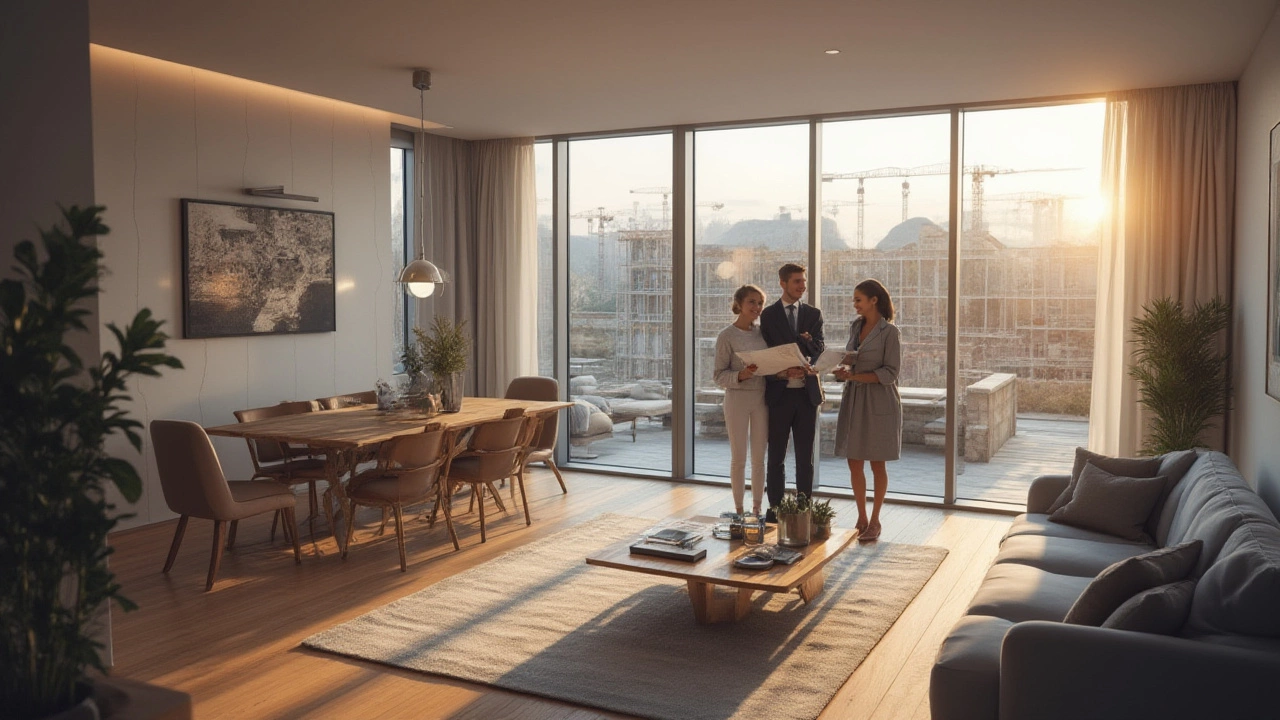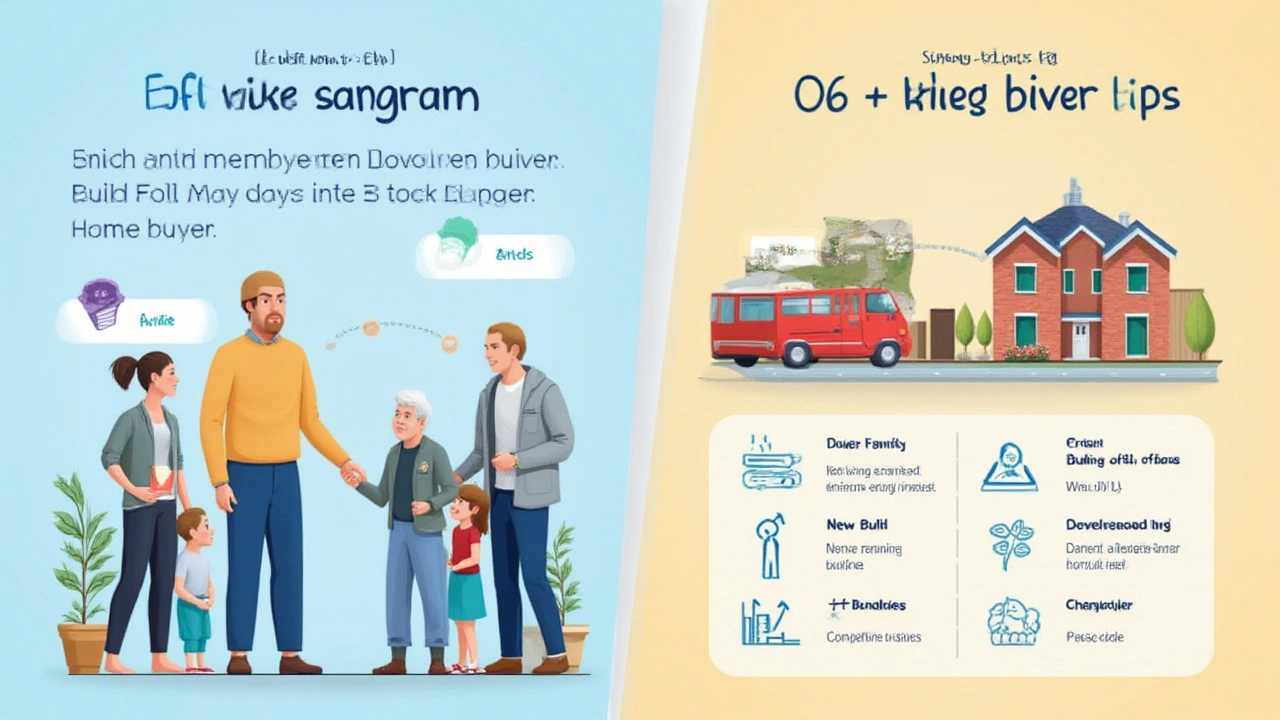New Build Meaning: What 'New Build' Really Means in Property and Construction
 Jul, 5 2025
Jul, 5 2025
If you've ever checked property listings, chances are you've run into the term "new build" more times than you've had hot dinners. For anyone dreaming about owning a home or looking to invest, these two words can sound exciting and even a bit mysterious. But have you ever wondered what "new build" actually means—beyond just being shiny and untouched?
What Does 'New Build' Really Mean?
You see the sign outside a brand-new development: "New Build Homes – Now Selling." But there’s more to it than just another fresh coat of paint. In the property world, a new build means a property that’s just been built, never lived in before—think homes plucked straight from the architect’s imagination and brought to life. In the UK, and most markets, "new build" usually covers homes built within the last two years—and sometimes, even a home that’s been standing empty since construction wraps up still counts.
Unlike renovated or converted properties, new build refers to projects started from scratch—greenfield sites, or brownfield land cleared out and given a fresh start. Major housebuilders handle the bulk of these, and you’ll see whole streets pop up at once, alongside shopping areas and parks. Builders must follow the latest building codes, so things like insulation, fire safety, and energy efficiency are held to high modern standards. That’s not just better for your wallet—it’s better for the planet too.
Here’s a quick look at what fits and what doesn’t in the "new build" box:
- Brand new homes or apartments, finished and sold directly from the builder or developer.
- Properties built as part of a regeneration scheme, replacing demolished buildings.
- Homes built and never occupied, sitting empty since completion.
Perks of Buying a New Build: More Than Meets the Eye
The idea of being the very first to walk through the front door is hard to beat. But there’s a stack of other reasons buyers keep falling for new builds. For starters, you get to sidestep the hassle of chain buying. No waiting on someone else’s move-out plans; the home’s yours as soon as the paint dries (or, more often, once the keys are handed over).
Worried about repairs? Most new builds are covered by a 10-year warranty, like the NHBC Buildmark guarantee in the UK. That covers structural issues and major faults, which older homes just don’t offer. It means less worry about unexpected bills clogging up your future.
New builds aren’t just energy efficient—they set the gold standard. According to a study by the Home Builders Federation, moving into a new build home in England and Wales, as of 2024, can save a family around £2,600 a year on energy costs compared to a similar-sized older property. That’s a chunky saving and it's no joke with today’s energy prices. Most new builds are rated EPC B or better, thanks to double glazing, top-notch insulation, and modern boilers or even air-source heat pumps.
Then there’s design. You decide on finishes: kitchen units, bathroom tiles, even plug socket locations if you buy off-plan. Want a home office or bigger storage? Most builders let you specify custom touches. Plus, you won’t inherit dodgy DIY jobs or faded wallpaper from past owners.
Here’s how new builds often stack up against older properties:
| Feature | New Build Homes | Older Properties |
|---|---|---|
| Energy rating | EPC A/B, high insulation | Lower rating, usually C-E |
| Structural warranty | 10 years standard | Rare, if at all |
| Customization | Often possible | Only through renovation |
| Upfront repairs | Rare | Common (roof, wiring) |
| Running costs | Lower (up to 60% less energy) | Higher |
| Resale value | Slow first few years | Established market |

The Flipside: Drawbacks Worth Considering
As much as all those perks sparkle, new build properties come with their own set of reality checks. The price tag is usually higher per square foot than similar older homes. You’re paying a premium, mostly for the blank-slate factor—and sometimes, for the privilege of picking your tiles.
Ever heard of “new build premium”? That’s when the price for the brand-new feel is tacked onto the ticket. Just like a new car, the moment you “drive it off the lot”—move in—the property value might dip. Cold comfort if you’re planning a quick flip. According to UK Land Registry data from early 2025, new build homes resold in the first year often lose 5%-10% compared to what their first owners paid. It’s less of an issue if you’re planning to stay put for a few years, but for short-term moves, it’s something to chew on.
There’s also the snag of space. Many new builds—especially apartments—come with smaller room sizes than you'd find in a Victorian or 1950s property. Developers squeeze more homes onto sites, so you may notice cozy living rooms or garden patches barely big enough for a barbecue. If you’ve got a growing family, double check those floorplans.
And then, there’s the "snag list." Basically, small issues builders need to fix after moving in—loose handles, scuffed paint, windows not quite flush. Reputable builders fix them fast, but it sometimes takes a few visits to get everything perfect. A recent HomeOwners Alliance survey found that 94% of new build owners in England reported at least one "snag" in their first year—though most were sorted within weeks. Tip: Keep a log and chase the developer’s customer-care until every niggle’s checked off.
So, yes, new builds come with shiny extras, but also a few growing pains. That’s why savvy buyers balance the pros with honest looks at the cons.
How to Buy a New Build: Top Tips and Must-Knows
If you’re ready to make the leap, shopping for a new build is its own adventure. The process is a bit different from snapping up a second-hand home from existing owners.
Here’s how it usually goes:
- Find a development: Start with big names—Barratt, Taylor Wimpey, Bellway in the UK, or names like D.R. Horton and Lennar in the USA. Visit show homes and pepper the sales staff with questions. Don’t fall for the soft music and coffee aroma alone—check the build quality, fixtures, and neighborhood vibe.
- Reserve your plot: If you love what you see, you’ll need to cough up a reservation fee—usually £500-£2,000. It’s a holding deposit, not a commitment. Ask what’s covered and when it’s refundable.
- Read the plans: Review everything—site layouts, floorplans, which direction the garden faces, what’s included or classed as an “extra.” Parking spots, landscaped fronts, even sockets can cost extra. Get it in writing.
- Check incentives: Developers dangle deals like paying your stamp duty, flooring upgrades, or white goods thrown in. Compare offers, but don’t let a shiny “free carpet” sway you into overlooking other fees.
- Sort your mortgage early: Some lenders have tighter criteria for new builds or require a bigger deposit, especially on apartments—sometimes 15% or more. Hunt for New Build-friendly mortgage products and factor in the move-in timescale, which can slip if the build overruns.
- Use a conveyancer: Choose a solicitor who knows new builds inside out. There are unique contracts, and you’ll want every term, warranty, and completion date nailed down tight.
- Snagging survey: Before you accept the keys, get an independent snagging survey. They’ll spot issues you might overlook and send the developer a list to fix before you move in.
Pro tip: Don’t just trust “ready-to-move-in” dates. Delays are common—anything from bad weather to supply chain snags can nudge timelines back. Always have a Plan B if you’re selling up or ending a rental.
For first-time buyers, special help-to-buy schemes still pop up—these might mean smaller deposits or government loans. In 2024-25, over 21,000 homes were bought with help-to-buy or shared ownership in England alone, so it's worth seeing what's available where you live.

What to Watch Out for: Legal, Fees, and Aftercare
Diving into a new build comes with paperwork galore. There are a few traps buyers sometimes fall into, but you can dodge them with some basics.
Check the developer’s reputation. Look for online reviews, ask residents of finished homes nearby, or visit Trustpilot and the NHBC database. Larger firms have a track record, but smaller outfits—or new companies—can be wild cards. In rare cases, developers go bust before completion. Ask your conveyancer about deposit protection and what happens if things go south.
Watch the leasehold versus freehold debate. In some regions, new build houses are sold on a leasehold basis—not just flats—which means annual ground rent payments. There’s been loud outcry about this, and new laws in 2024 have capped ground rents in England and Wales, but read your contract: can you buy the freehold? What are the service charges?
Don’t skip the fine print on completion timelines. Some contracts use "longstop dates"—if the property isn’t finished in time, you may be owed compensation. But without clear terms, you risk endless delays.
After you move in, remember snagging isn’t a one-off. Many developers guarantee the first two years for all repairs, with longer cover on major structure. Don’t let issues fester—log and report everything. Insist on end-of-warranty checks about 12 months in, as some problems (like settlement cracks) take time to show.
Finally, keep tabs on your running costs. Monitor those utility bills and compare them to the promises made in the builder’s brochure. If they’ve over-promised, don’t be shy about raising it with them or your local trading standards office.
To help you keep track, here’s a quick checklist every buyer should have saved to their phone:
- Developer’s reputation and reviews
- Details of warranties and guarantees
- Contract terms and completion timelines
- Included features and extras, in writing
- Independent snagging survey report
- Utilities and service charge breakdowns
Being clued up means you’ll get the fun parts of new build ownership—and sidestep the headaches. With the right checks (and a little patience), there's a lot to love about saying you were the first to cross that new doorstep.
